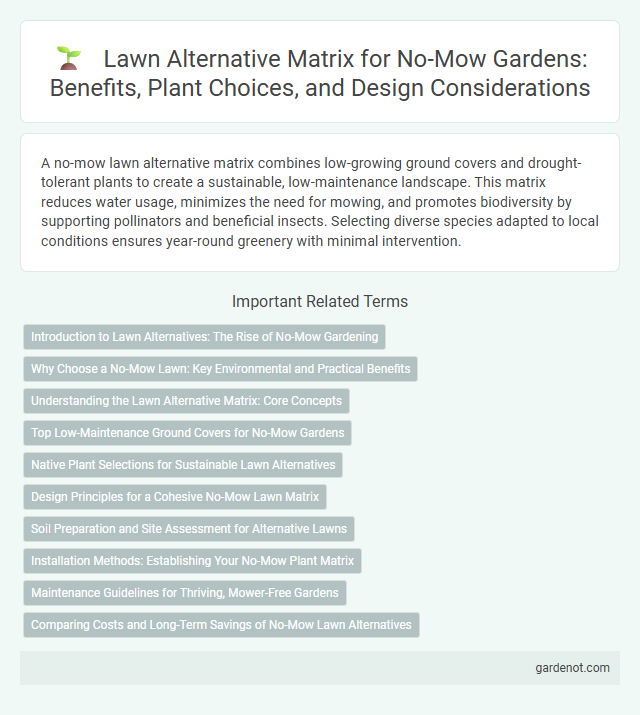A no-mow lawn alternative matrix combines low-growing ground covers and drought-tolerant plants to create a sustainable, low-maintenance landscape. This matrix reduces water usage, minimizes the need for mowing, and promotes biodiversity by supporting pollinators and beneficial insects. Selecting diverse species adapted to local conditions ensures year-round greenery with minimal intervention.
Introduction to Lawn Alternatives: The Rise of No-Mow Gardening
No-mow gardening offers a sustainable alternative to traditional lawns by reducing the need for regular mowing, watering, and chemical treatments. This approach often utilizes hardy ground covers, native grasses, and low-maintenance plants that thrive with minimal intervention. Embracing no-mow alternatives contributes to biodiversity, conserves water, and lowers carbon emissions associated with lawn care.
Why Choose a No-Mow Lawn: Key Environmental and Practical Benefits
No-mow lawns significantly reduce water consumption by eliminating the need for frequent irrigation, promoting sustainable water use. They enhance biodiversity by providing habitats for pollinators such as bees and butterflies, contributing to healthier local ecosystems. Reduced maintenance also lowers fossil fuel emissions from lawn mowers, making no-mow lawns an eco-friendly and cost-effective alternative to traditional grass lawns.
Understanding the Lawn Alternative Matrix: Core Concepts
The Lawn Alternative Matrix categorizes ground cover options based on factors such as maintenance level, environmental impact, and aesthetic appeal, providing a framework for selecting sustainable lawn substitutes. Key components include low-water plants, pollinator-friendly species, and durable ground covers that reduce carbon footprint and promote biodiversity. Understanding these core concepts enables homeowners to optimize green spaces while minimizing resource consumption and enhancing ecosystem health.
Top Low-Maintenance Ground Covers for No-Mow Gardens
Clover, creeping thyme, and sedum are top low-maintenance ground covers ideal for no-mow lawns, offering drought tolerance and natural weed suppression. These alternatives require minimal watering, resist pests, and provide vibrant greenery or flowering, enhancing aesthetic appeal without regular mowing. Selecting these ground covers reduces lawn care time while promoting eco-friendly, sustainable garden practices.
Native Plant Selections for Sustainable Lawn Alternatives
Native plant selections for sustainable lawn alternatives provide a low-maintenance, eco-friendly matrix that naturally supports local biodiversity. These no-mow lawns reduce water usage, minimize chemical inputs, and enhance soil health by incorporating deep-rooted native grasses and wildflowers. Choosing region-specific native species ensures adaptability and resilience, promoting a thriving, self-sustaining landscape that benefits pollinators and wildlife.
Design Principles for a Cohesive No-Mow Lawn Matrix
Design principles for a cohesive no-mow lawn matrix emphasize selecting drought-tolerant, low-maintenance ground covers such as clover, creeping thyme, and sedum to ensure year-round greenery and reduced water usage. Incorporating native plant species enhances ecological balance and supports local pollinators while minimizing pest issues. Strategic layering and spacing of diverse plants create texture, color variation, and resilience, eliminating the need for frequent mowing and chemical inputs.
Soil Preparation and Site Assessment for Alternative Lawns
Soil preparation and site assessment are crucial for establishing a no-mow lawn alternative, ensuring optimal growth and sustainability. Testing soil pH, nutrient levels, and drainage characteristics guides necessary amendments to create a fertile, well-draining base suitable for native grasses, clover, or ground covers. Identifying existing vegetation, sunlight exposure, and soil compaction helps tailor the lawn alternative matrix for minimal maintenance and enhanced environmental benefits.
Installation Methods: Establishing Your No-Mow Plant Matrix
Installation of a no-mow lawn matrix involves selecting drought-tolerant, low-maintenance ground covers such as creeping thyme, sedum, and clover, which establish quickly and require minimal care. Preparation includes soil aeration, proper seed or plug spacing, and ensuring adequate irrigation during initial growth to promote deep rooting and weed resistance. Utilizing techniques like layering with mulch or biodegradable mats can enhance soil moisture retention and protect young plants for a more successful establishment.
Maintenance Guidelines for Thriving, Mower-Free Gardens
Choosing resilient ground covers like clover, creeping thyme, or native grasses reduces the need for mowing while promoting soil health and biodiversity. Regularly monitoring moisture levels and applying organic mulch suppresses weeds and retains hydration, enhancing plant vigor in mower-free gardens. Implementing seasonal pruning and spot weeding maintains aesthetic appeal without disrupting the low-maintenance ecosystem.
Comparing Costs and Long-Term Savings of No-Mow Lawn Alternatives
No-mow lawn alternatives such as clover, native grasses, and groundcovers significantly reduce maintenance costs by eliminating regular mowing, watering, and fertilizing expenses. Initial installation costs vary, with clover generally being the most affordable option, while native grasses may require higher upfront investment but offer greater drought resistance and lower long-term water usage. Over time, these alternatives deliver substantial savings through reduced labor, equipment upkeep, and environmental benefits, making them cost-effective sustainable landscaping solutions.
Lawn alternative matrix Infographic

 gardenot.com
gardenot.com